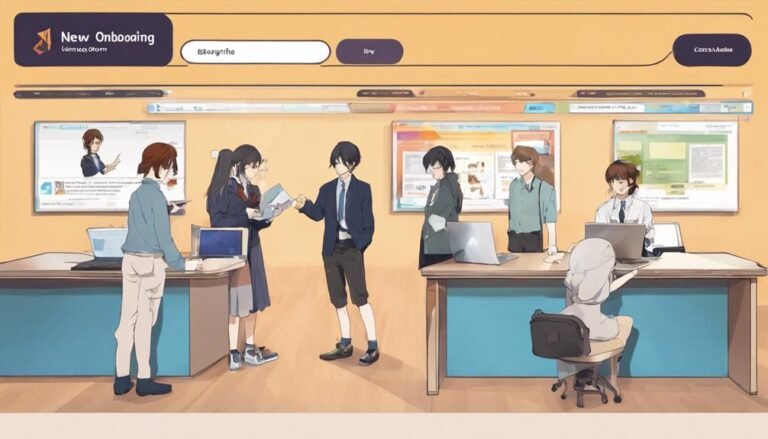How Can I Foster Collaboration and Teamwork in Online Learning Environments?
To foster collaboration and teamwork in online learning environments, prioritize clear communication, encourage peer feedback, facilitate virtual group activities, utilize online tools, and nurture a supportive culture. Establish rapport with peers, be open to diverse opinions, and actively participate. Offer constructive feedback, use virtual team-building exercises, and assign roles for accountability. Engage in virtual brainstorming, use online collaboration tools like whiteboarding, and track progress with task management platforms. Cultivate trust, celebrate successes, and appreciate everyone's contributions. By following these strategies, you can create a thriving online learning community where teamwork flourishes.
Key Takeaways
- Establish clear communication channels for effective collaboration.
- Encourage peer-to-peer feedback to enhance learning outcomes.
- Facilitate virtual group activities to build camaraderie.
- Utilize collaborative online tools for efficient teamwork.
- Foster a culture of mutual support to boost productivity.
Establish Clear Communication Channels
To promote collaboration in online learning environments, make sure that clear communication channels are established from the beginning. Establishing rapport with your peers is essential for creating a conducive environment for learning and working together effectively. When communication channels are open and transparent, it promotes engagement and encourages active participation from all team members.
To establish rapport with your peers, start by introducing yourself and sharing a bit about your background or interests. This helps in breaking the ice and creating a friendly atmosphere within the group. Encourage others to do the same to foster a sense of connection and community. Additionally, actively listen to what others have to say, show empathy, and be respectful of diverse opinions and perspectives.
Promoting engagement involves not only sharing your thoughts and ideas but also actively seeking input from others. Encourage open discussions, ask for feedback, and be willing to collaborate on tasks and projects. By creating a supportive and communicative environment, you can enhance collaboration and teamwork in online learning settings.
Encourage Peer-to-Peer Feedback
Encouraging your peers to provide feedback to each other can greatly enhance collaboration and learning outcomes in online environments. Peer evaluation offers a unique perspective that can help individuals grow and learn from each other. By fostering a culture of feedback exchange, you create a supportive environment where everyone has a voice and contributes to each other's development.
To promote peer-to-peer feedback, lead by example. Offer constructive feedback yourself and demonstrate the value it brings. Provide guidelines on how to give and receive feedback effectively, emphasizing the importance of being respectful and specific. Encourage peers to focus on both strengths and areas for improvement, fostering a balanced perspective.
Create opportunities for peer evaluation within group projects or discussions. Assign feedback roles to different team members, rotating these roles to make sure everyone participates. Establish clear criteria for evaluation to guide peers in providing meaningful feedback. By promoting peer-to-peer feedback, you empower individuals to take ownership of their learning and contribute actively to the collaborative environment.
Facilitate Virtual Group Activities
To enhance collaboration and engagement in online learning environments, consider implementing various strategies to facilitate virtual group activities effectively. Virtual icebreakers and team-building exercises can help break the ice and establish a sense of camaraderie among online learners. These activities can include fun introductions, virtual scavenger hunts, or even online escape rooms to encourage interaction and teamwork.
When it comes to online problem-solving and brainstorming, providing clear instructions and goals is essential. Encourage participants to use online collaboration tools like shared documents or virtual whiteboards to brainstorm ideas collectively. Break down complex problems into smaller tasks and assign roles to each team member to promote a sense of responsibility and accountability within the group.
Utilize Collaborative Online Tools
If you want to enhance collaboration in online learning, leverage collaborative online tools for seamless interaction and productivity. Remote collaboration and digital teamwork are essential in today's virtual learning environments. By utilizing these tools effectively, you can create a dynamic and engaging space for your team to work together towards common goals.
- Virtual Brainstorming: Encourage creativity and idea generation through virtual brainstorming sessions where all team members can contribute their thoughts.
- Online Whiteboarding: Foster visual collaboration by using online whiteboarding tools to illustrate concepts, map out ideas, and solve problems collectively.
- Real-time Collaboration: Enable real-time collaboration on documents, projects, and presentations to enhance efficiency and teamwork.
- Task Management Platforms: Utilize task management platforms to assign tasks, track progress, and make sure everyone is on the same page.
- Communication Channels: Establish clear communication channels for instant messaging, video calls, and group discussions to keep everyone connected and informed.
Foster a Culture of Mutual Support
Create a supportive environment where team members can rely on each other for assistance and encouragement, fostering a culture of mutual support in your online learning community. Team building is essential in online environments to enhance collaboration and productivity.
Encourage open communication channels where individuals feel comfortable reaching out for help or sharing ideas. Establishing trust is fundamental; team members need to feel secure in expressing their thoughts and concerns without judgment.
Acknowledge and appreciate each other's contributions to reinforce a sense of belonging and value within the team. Regularly check in on team members to see how they're doing and offer assistance when needed. Celebrate successes together and provide constructive feedback to promote growth and improvement.
By fostering a culture of mutual support, you create a positive and inclusive environment where everyone feels empowered to contribute their best. Trust building is an ongoing process that requires active participation and commitment from all team members.
Together, you can create a strong and supportive community that thrives on collaboration and teamwork.
Conclusion
As you work to foster collaboration and teamwork in your online learning environment, remember that clear communication, peer feedback, group activities, collaborative tools, and mutual support are key.
By implementing these strategies, you can create a supportive and engaging online community that encourages cooperation and shared success.
Keep pushing forward, knowing that your efforts will pay off in a more connected and effective online learning experience for all involved.
You've got this!







